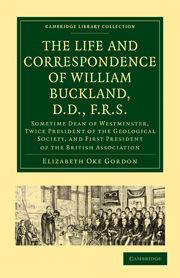 The Life and Correspondence of William Buckland, D.D., F.R.S.
The Life and Correspondence of William Buckland, D.D., F.R.S. CHAPTER II
Published online by Cambridge University Press: 05 November 2011
Summary
“La vie des savans nous enseigne à chaque page que les grandes vérités n'ont été découvertes et établies que par des études prolongées, solitaires, dirigées constamment vers un objêt spécial, guidées sans cesse par une logique méflante et réservée.”
—Cuvier.In the summer of 1808 Buckland made his first geological tour. Alone and on horseback he travelled from Oxford across the chalk hills of Berks and Wilts and Dorset to Corfe Castle in the Isle of Purbeck. In the vertical strata of hard white limestone on which that castle stands he recognised the chalk, but the relations of the strata above and below that formation were then unknown. In the following year he explored in the same way a large part of South Devon, visiting the granite of Dartmoor, examining minutely the formations, and collecting specimens of the geology of the district. In 1810 he made a tour through the centre and north of England, examining the then unknown extent of the various strata, and colouring the results on Carey's large map of England.
Other journeys followed in annual succession. Thus in 1813 Buckland, adopting the true Wykehamical fashion of going two and two, made a tour with his friend Mr. W. Conybeare in Ireland. In collaboration with his travelling companion, he published his first important paper—“On the Coasts of the North of Ireland.” Among the organic remains in many of the chalk pits from Moira to Belfast and Larne he discovered some curious siliceous bodies known by the name of “Paramoudra.”
- Type
- Chapter
- Information
- The Life and Correspondence of William Buckland, D.D., F.R.S.Sometime Dean of Westminster, Twice President of the Geological Society, and First President of the British Association, pp. 11 - 54Publisher: Cambridge University PressPrint publication year: 2010First published in: 1894
